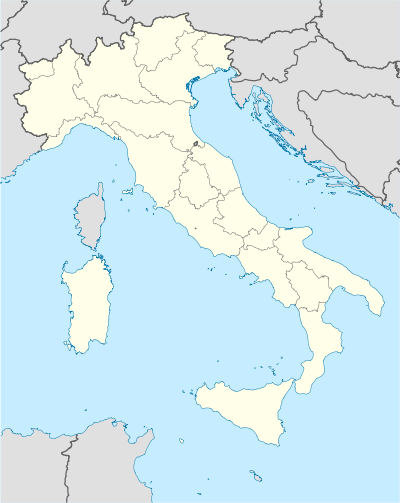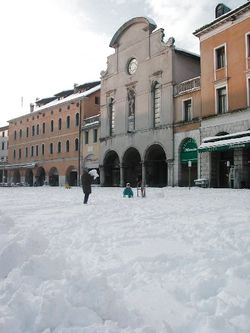Belluno
| Belluno | |
|---|---|
| — Comune — | |
| Comune di Belluno | |
 |
|
 Belluno
|
|
| Coordinates: | |
| Country | Italy |
| Region | Veneto |
| Province | Belluno (BL) |
| Frazioni | see list |
| Government | |
| - Mayor | Antonio Prade (PdL) |
| Area | |
| - Total | 147.18 km2 (56.8 sq mi) |
| Elevation | 390 m (1,280 ft) |
| Population (30 April 2009) | |
| - Total | 36,506 |
| - Density | 248/km2 (642.4/sq mi) |
| Demonym | Bellunesi |
| Time zone | CET (UTC+1) |
| - Summer (DST) | CEST (UTC+2) |
| Postal code | 32100 |
| Dialing code | 0437 |
| Patron saint | Saint Martin |
| Saint day | 11 November |
| Website | Official website |
.jpg)

Belluno (Italian: Belluno; Venetian: Belun; German: Beilun) is a town and comune in the Veneto region of northern Italy. Located about 80 kilometers north of Venice, Belluno is the capital of the province of Belluno and the most important city in the Eastern Dolomiti's region. With its roughly 35,000 inhabitants, it the largest populated area of Valbelluna. It is one of the 15 municipalities of the Parco Nazionale delle Dolomiti Bellunesi.
Contents |
Geography
The ancient city of Belluno rises above a cliff spur near the confluence of the Torrente Ardo and the Piave River. To the north is the imposing Schiara range of the Dolomites, with the famous Gusela del Vescovà (Bishopric's needle), and Mounts Serva and Talvena rising above the city. To the south, the foothills of the Alps separate Belluno from the Venetian plain. Further to the south is the Nevegal, in the Castionese area, well-known for its skiing resorts. The average annual temperature in Belluno is 9°C (49°F), and the average annual precipitation is 137 cm (54 inches). Its great for sports and other outdoor activities
History
The name of the city is derived from celtic belo-dunum which means "splendid hill". The name was inspired by the favorable position within the valley.
The city was founded around 220-200 BC by the Romans and, starting from 181 BC, it became an important military stronghold in the Roman Venetia. After the fall of the Western Roman Empire, it was ruled by the Lombards (6th century) and the Carolingians (8th century); from the late 9th century it was ruled by a count-bishop and it received a castle and a line of walls. Later it was a possession of the Ghibelline family of the Ezzelino. After having longly contended the nearby territory with Treviso, in the end Belluno gave itself to the Republic of Venice (1404). The city was thenceforth an important hub for the transport of lumber from the Cadore through the Piave river.
After the fall of the Republic, Belluno was an Austrian possession, until it was annexed to the Kingdom of Italy in 1866.
Main sights
- The Duomo (Cathedral, late 15th century), with the 18th century bell tower designed by Filippo Juvarra. The church's plan is attributed to the Venetian architect Tullio Lombardo
- Palazzo dei Rettori (1491)
- The red edifice of the Communal Palace
- The Bishop's Palace, erected in 1190 by the count-bishop Gerardo de' Taccoli
- The Fountain of Piazza del Duomo
- Baroque church of San Pietro (1326), originally in Gothic style. It includes five paintings by Andrea Schiavone, three by Sebastiano Ricci.
- Palazzo del Capitano.
- The 16th century church of San Rocco.
- The church of Santo Stefano, housing several 15th century paintings by local masters. It includes also an Adoration of the Magi from Tiziano's workshop.
- The Romanesque church of San Biagio.
- The Porta Dojona and Porta Rugo gates in the ancient walls.
- The 16th church of Santa Maria dei Battuti.
Frazioni
Antole, Bes, Bolzano Bellunese, Caleipo-Sossai, Castion, Castoi, Cavessago, Cavarzano, Cet, Chiesurazza, Cirvoi, Col di Piana, Col di Salce, Collungo, Cusighe, Faverga, Fiammoi, Giamosa, Giazzoi, Levego, Madeago, Miér, Nevegal, Orzes, Pedeserva, Pra de Luni, Rivamaor, Safforze, Sala, Salce, San Pietro in Campo, Sargnano, Sois, Sopracroda, Sossai, Tassei, Tisoi, Vezzano, Vignole, Visome.
Quarters
Baldenich, borgo Garibaldi (o via garibaldi), Borgo Piave, Borgo Prà, Cavarzano, Mussoi, San Lorenzo, Quartier Cadore, Via Feltre-Maraga, San Francesco, Lambioi, Via Montegrappa, Via Cairoli
Transportation
Belluno is connected by state roads to Feltre, Treviso, Ponte nelle Alpi and Vittorio Veneto. It has also a railway station.
The bus station is on the Piazzale della Stazione next to the railway station.
Notable residents
- Marco Paolini (b. 1956), stage actor
Twin towns — Sister cities
Belluno is twinned with:
 Cervia, Italy
Cervia, Italy
External links
|
|||||||